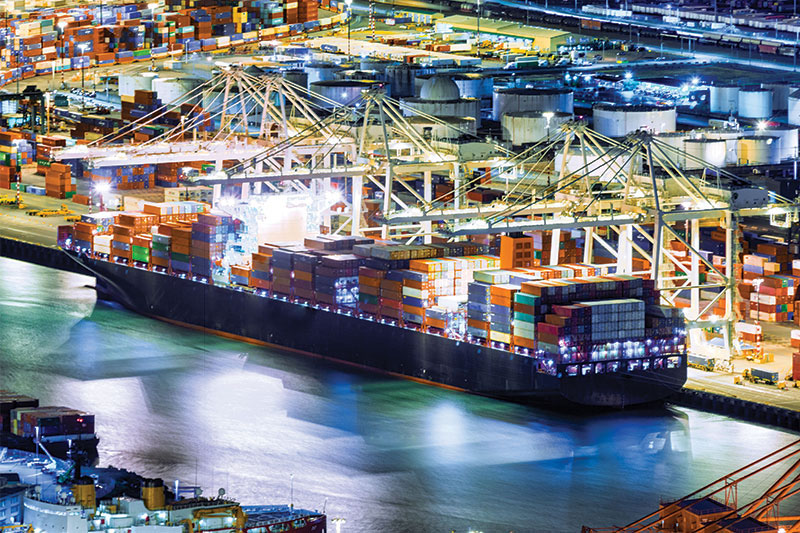Port Tracker report points to import volume growth over the first half of 2024
For calendar year 2023, total U.S.-bound retail container imports, at 22.3 million TEU, were down 12.8% compared to 2022. The report observed that this was in line with expectations, adding that the shift to growth in its forecast is intact.

Amid the ongoing series of attacks on the Red Sea shipping lane by the Yemeni Houthi pirates in response to the ongoing Israel-Palestine conflict, United States-bound retail import volumes are poised to see annual gains over the first half of 2024, according to the new edition of the Port Tracker report, which was issued today by the National Retail Federation (NRF) and maritime consultancy Hackett Associates.
The ports surveyed in the report include: Los Angeles/Long Beach; Oakland; Tacoma; Seattle; Houston; New York/New Jersey; Hampton Roads; Charleston, and Savannah; Miami; Jacksonville; and Fort Lauderdale, Fla.-based Port Everglades.
Authors of the report explained that cargo import numbers do not correlate directly with retail sales or employment because they count only the number of cargo containers brought into the country, not the value of the merchandise inside them, adding that the amount of merchandise imported provides a rough barometer of retailers’ expectations.
“Only about 12% of U.S.-bound cargo comes through the Suez Canal but the situation in the Red Sea is bringing volatility and uncertainty that are being felt around the globe,” NRF Vice President for Supply Chain and Customs Policy Jonathan Gold said in a statement. “U.S. retailers are working to mitigate the impact of delays and increased costs. However, the longer the disruptions occur, the bigger impact this could have. More needs to be done among partners and allies to ensure the safety of vessels and crews in order to avoid yet another year of supply chain disruption.”
For December, the most recent month for which data is available, Port Tracker reported that import volume, for the ports covered in the report, came in at 1.87 million Twenty-Foot Equivalent Units (TEU), a 1% decrease compared to November, and an 8.3% annual increase.
Port Tracker issued projections for January and the subsequent months, including:
- January, at 1.81 million TEU, for a 0.3% annual increase;
- February (which is typically the slowest month of the year, due to Lunar New Year factory shutdowns in Asia, with the timing of the holiday and its impact on cargo and annual comparisons varying), at 1.86 million TEU, for a 20.4% annual increase;
- March, at 1.71 million TEU, for a 5.5% annual increase;
- April, at 1.83 million TEU, for a 2.6% annual increase;
- May, at 1.94 million TEU, for a 0.3% annual increase; and
- June, at 1.93 million TEU, for a 5.5% annual increase
For calendar year 2023, total U.S.-bound retail container imports, at 22.3 million TEU, were down 12.8% compared to 2022. The report observed that this was in line with expectations, adding that the shift to growth in its forecast is intact.
Should these numbers come to fruition, total volume for the first half of 2024 would come in at 11.1 million TEU, a 5.3% annual gain compared to the same period in 2023.
Hackett Associates Founder Ben Hackett wrote in the report that while the Red Sea disruptions remains a global supply chain concern, the shipping sector has quickly made adjustments through the addition of extra vessels into its networks and returning to normal weekly ship arrivals.
“They have also added transshipment points in Sri Lanka and at the western end of the Mediterranean,” he wrote. “Service from Asia to the U.S. East Coast is working well and the dramatic rise in freight rates is showing signs of easing, with pressure from shippers likely to quickly bring these down. The Red Sea situation is hardly impacting the majority of Asia-U.S. shipping, and the water-level problems at the Panama Canal that could have required rerouting via the Red Sea have not had much impact on container ships.”

Article Topics
Hackett Associates News & Resources
U.S.-bound import growth track remains promising, notes Port Tracker report Three major heavy truck manufacturers form PACT to jolt electrification push Port Tracker report points to import volume growth over the first half of 2024 Shippers look at alternatives amid Red Sea Crisis Port Tracker points to U.S.-bound import gains in the coming months While volumes are down, August growth is in the cards, reports Port Tracker Port Tracker report notes August imports will hit a peak amid various labor issues More Hackett AssociatesLatest in Logistics
Understanding the FTC’s ban on noncompetes UPS rolls out fuel surcharge increases U.S. rail carload and intermodal volumes, for week of April 20, are mixed, reports AAR Baltimore suing ship that crashed into bridge, closing port, costing jobs Intermodal growth volume remains intact in March, reports IANA Descartes announces acquisition of Dublin, Ireland-based Aerospace Software Developments Amid ongoing unexpected events, supply chains continue to readjust and adapt More LogisticsAbout the Author
Subscribe to Logistics Management Magazine

Find out what the world's most innovative companies are doing to improve productivity in their plants and distribution centers.
Start your FREE subscription today.
April 2023 Logistics Management

Latest Resources














